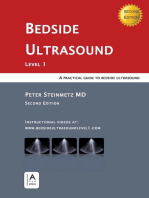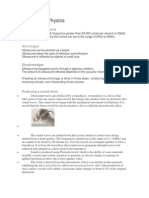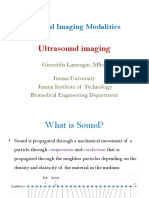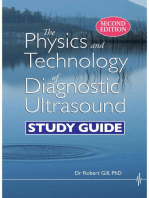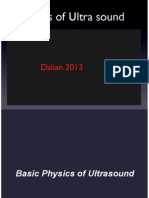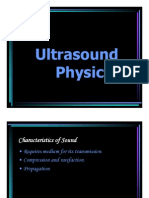Ultrasound Imaging
Ultrasound Imaging
Uploaded by
Sitanshu SatpathyCopyright:
Available Formats
Ultrasound Imaging
Ultrasound Imaging
Uploaded by
Sitanshu SatpathyOriginal Description:
Copyright
Available Formats
Share this document
Did you find this document useful?
Is this content inappropriate?
Copyright:
Available Formats
Ultrasound Imaging
Ultrasound Imaging
Uploaded by
Sitanshu SatpathyCopyright:
Available Formats
By:
Sitanshu Satpathy
Nishant Gupta
Characteristics of sound waves
Categorisation of sound waves
Ultrasound
Sound waves above 20 KHz are usually called as ultrasound
waves.
These propagate mechanical energy causing periodic vibration
of particles in a continuous, elastic medium.
Cannot propagate in a vacuum since there are no particles of
matter in the vacuum.
It is propagated through continuous compressions and
rarefactions through the neighbor particles depending on the
density and elasticity of the material in the medium.
The velocity of the sound in
Air: 331 m/sec; Water: 1430 m/sec
Soft tissue: 1540 m/sec; Fat: 1450 m/sec
Ultrasound medical imaging: 2MHz to 10 MHz
2 MHz to 5 MHz frequencies are more common.
5 MHz ultrasound beam has a wavelength of 0.308 mm in soft
tissue with a velocity of 1540 m/sec.
Bats navigate using
ultrasound
Bats make high-pitched chirps which are too high for
humans to hear. This is called ultrasound.
Like normal sound, ultrasound echoes off objects.
The bat hears the echoes and works out what caused
them.
Dolphins also navigate with ultrasound.
Submarines use a similar method called sonar.
o If a bat hears an echo 0.01 second after it makes a
chirp, how far away is the object?
o Clue 1: the speed of sound in air is 330 ms
-1
o Clue 2: The speed of sound equals the distance
travelled divided by the time taken
o Answer: distance = speed x time
o Put the numbers in:
distance = 330 x 0.01 = 3.3 m
o But this is the distance from the bat to the object and
back again, so the distance to the object is 1.65 m.
We can also use ultrasound to look
inside the body .
Ultrasound Physics
Transducer
Piezoelectric crystal
Emit sound after electric charge
applied
Sound reflected from patient
Returning echo is converted to
electric signal grayscale image
on monitor
Echo may be reflected, transmitted
or refracted due to inhomogeneity
Transmit 1% and receive 99% of
the time
Ultrasound Imaging
How does it work ??
An ultrasound element acts like a bat.
Emit ultrasound and detect echoes
Map out boundary of object
Now put many elements together to
make a probe and create an image
Ultrasound tissue
interaction
As the ultrasound beam travels through tissue layers, the
amplitude of the original signal becomes attenuated as the
depth of penetration increases due to
1. Absorption = energy is captured by the tissue then
converted to heat
2. Reflection = occurs at interfaces between tissues of
different acoustic properties
3. Scattering at interfaces = beam hits irregular interface
beam gets scattered
attenuation can be minimized
by using time gain control
Sound propagation
Tissue Average
Attenuation
Coefficient in
dB/cm at 1 MHz
Propagation
Velocity of Sound
in m/sec
Fat 0.6 1450
Liver 0.8 1549
Kidney 0.95 1561
Brain 0.85 1541
Blood 0.18 1570
This is a 2D ultrasound scan through the foot of a foetus. You can see
some of the bones of the foot. We can process the image in a computer
to find the outline of the foot. This is called surface rendering.
Imaging system
Piezoelectric
crystal
Acoustic
absorbers
Blockers
Imaging
Object
Transmitter/
Receiver
Circuit
Control
Circuit
Pulse
Generation
and Timing
Data-Acquisition
Analog to Digital
Converter
Computer
Imaging
Storage and
Processing
Display
Instrumentation
Probes ( curvy , linear or
rectangular , small area )
Monitor
Image control
Modes of display
A mode
Spikes where precise length and depth
measurements are needed ophtho
B mode (brightness) used most often
2 D reconstruction of the image slice
M mode motion mode
Moving 1D image cardiac mainly ( blood flow )
(uses doppler effect) ( as blood flows away reflected
echo has larger wavelength and vice versa)
Artifacts
Acoustic shadowing
Ultrasound beam does not pass
through an object because of reflection
or absorption
Black area beyond the surface of the
reflector
Examples: cystic calculi, bones
Acoustic enhancement
Hyper intense (bright) regions below
objects of low ultrasound beam
attenuation
Through transmission
Examples: cyst
Guidelines for the safe use of ultrasound
therapy devices
1. Ultrasound is energy and is absorbed by tissue, causing
heating so during ultrasound therapy patient should be
continuously monitored.
2. If any painful sensation is felt by the patient then its an
indication of overheating of bones.
3. Proper coupling of applicator surface with the patient (using
ultrasound gel)/
4. During pregnancy patient should never receive any ultrasound
therapy it results in exposure to fetus.
5. Should not be applied over brains or spinal cord.
6. Should not be used if cardiac enhancements are used by the
patients.
7. Weak blood vessels may rupture on exposure.
8. Operator training.
You might also like
- The Physics and Technology of Diagnostic Ultrasound: A Practitioner's Guide (Second Edition)From EverandThe Physics and Technology of Diagnostic Ultrasound: A Practitioner's Guide (Second Edition)No ratings yet
- Bedside Ultrasound: Level 1 - Second EditionFrom EverandBedside Ultrasound: Level 1 - Second EditionRating: 5 out of 5 stars5/5 (1)
- Pass Ultrasound Physics Exam Study Guide ReviewFrom EverandPass Ultrasound Physics Exam Study Guide ReviewRating: 4.5 out of 5 stars4.5/5 (2)
- Physics Review PDFDocument27 pagesPhysics Review PDFRizahGepes100% (5)
- Physics PDFDocument47 pagesPhysics PDFstoicea_katalinNo ratings yet
- Ultrasound PhysicsDocument9 pagesUltrasound PhysicsawansurfNo ratings yet
- Ultrasound Made EasyDocument7 pagesUltrasound Made EasyAnonymous ZUaUz1wwNo ratings yet
- Ultrasound Question Bank (Final)Document9 pagesUltrasound Question Bank (Final)Mina AdelNo ratings yet
- Ultrasound ImagingDocument103 pagesUltrasound Imagingsolomong100% (1)
- Basic Principles of UltrasoundDocument38 pagesBasic Principles of UltrasoundredaradeNo ratings yet
- The Physics and Technology of Diagnostic Ultrasound: Study Guide (Second Edition)From EverandThe Physics and Technology of Diagnostic Ultrasound: Study Guide (Second Edition)No ratings yet
- Doppler UltrasoundDocument3 pagesDoppler UltrasoundDrShagufta IqbalNo ratings yet
- Basics of UltrasoundDocument89 pagesBasics of Ultrasoundazizah100% (4)
- Fundamentals of Ultrasound ImagingDocument11 pagesFundamentals of Ultrasound ImagingAryan Shukla100% (2)
- Introduction To Basic UltrasoundDocument25 pagesIntroduction To Basic UltrasoundAriadna Mariniuc100% (4)
- Physics (Basics) of UltrasoundDocument81 pagesPhysics (Basics) of Ultrasoundika harikarti100% (1)
- Pass Ultrasound Physics Exam Review Match the AnswersFrom EverandPass Ultrasound Physics Exam Review Match the AnswersRating: 4 out of 5 stars4/5 (4)
- Doppler BasicsDocument79 pagesDoppler Basicsdrabdulsamad100% (1)
- Lesson 10 - UltrasoundDocument62 pagesLesson 10 - UltrasoundDesignNo ratings yet
- Ultra PhysicsDocument30 pagesUltra PhysicsnidharshanNo ratings yet
- UltrasoundDocument78 pagesUltrasoundAmeer Matta100% (1)
- Slide Ultrasound Part 1Document27 pagesSlide Ultrasound Part 1Hanif HussinNo ratings yet
- Doppler Basics: DR - Priyatamjee BussaryDocument79 pagesDoppler Basics: DR - Priyatamjee BussarydrsanndeepNo ratings yet
- Basic Physics UltrasoundDocument68 pagesBasic Physics Ultrasounddrmamoon100% (4)
- UltrasoundDocument104 pagesUltrasoundlrp sNo ratings yet
- Physics of UltrasoundDocument45 pagesPhysics of UltrasoundStar Alvarez100% (1)
- Physics of UltrasoundDocument81 pagesPhysics of UltrasoundMarliya ulfa100% (2)
- Physics of UltrasoundDocument11 pagesPhysics of Ultrasoundcasolli100% (1)
- Martin (2015) - Physics of UltrasoundDocument4 pagesMartin (2015) - Physics of Ultrasoundgatorfan786No ratings yet
- Doppler Ultrasonography of The Lower Extremity ArteriesDocument34 pagesDoppler Ultrasonography of The Lower Extremity ArteriesNidaa MubarakNo ratings yet
- Ultrasound PhysicsDocument26 pagesUltrasound PhysicsAmi Desai50% (2)
- Principles and Instruments of Diagnostic UltrasoundDocument22 pagesPrinciples and Instruments of Diagnostic UltrasoundJames WangNo ratings yet
- Practical Physics of UltrasoundDocument31 pagesPractical Physics of UltrasoundJazib Shahid100% (2)
- Vascular Ultrasound TrainingDocument5 pagesVascular Ultrasound TrainingLyleHarris0% (1)
- Doppler UltrasoundDocument12 pagesDoppler UltrasoundMuhammad Shayan Farooq100% (1)
- Doppler PresentationDocument51 pagesDoppler PresentationPbawal100% (2)
- Mods of UltrasoundDocument22 pagesMods of UltrasoundEnrique Valdez JordanNo ratings yet
- Echo TutorialDocument156 pagesEcho Tutorialhanibalu100% (2)
- Ultrasound GuidanceDocument111 pagesUltrasound GuidanceRahmanandhikaNo ratings yet
- Knobology Image Optimization and Trans Views - ShookDocument5 pagesKnobology Image Optimization and Trans Views - ShookAmar Mahesh KalluNo ratings yet
- UltrasoundDocument175 pagesUltrasoundsky rain100% (15)
- Ultrasound Physics and Instrumentation Content OutlineDocument19 pagesUltrasound Physics and Instrumentation Content OutlineSherif H. Mohamed100% (2)
- USG ImagingDocument26 pagesUSG ImagingskNo ratings yet
- Ultrasound Scanning ManualDocument418 pagesUltrasound Scanning Manualabdirashid95% (19)
- Ultrasound Guided ProceduresDocument71 pagesUltrasound Guided Proceduresg1381821No ratings yet
- New UltrasoundDocument30 pagesNew Ultrasoundamittewarii100% (1)
- Emergency Sonography For Trauma FAST Protocol 2010 PDFDocument101 pagesEmergency Sonography For Trauma FAST Protocol 2010 PDFChavo Delocho100% (9)
- Ultrasound BasicsDocument12 pagesUltrasound BasicsJ100% (1)
- ULTRASOUNDDocument14 pagesULTRASOUNDpriyadharshini100% (1)
- Vascular Ultrasound Protocol Guide PDFDocument28 pagesVascular Ultrasound Protocol Guide PDFchica_as100% (2)
- Quickie PCC Finals Reviewer (Radiology) : SpikesDocument4 pagesQuickie PCC Finals Reviewer (Radiology) : Spikesroseanne_erika100% (1)
- Lower Extremity Venous Protocol 14Document3 pagesLower Extremity Venous Protocol 14api-276847924No ratings yet
- Probe Selection Machine Controls Equipment MGHillDocument14 pagesProbe Selection Machine Controls Equipment MGHilljohnalanNo ratings yet
- Ultrasound Transducers and ResolutionDocument107 pagesUltrasound Transducers and ResolutionPapadove0% (1)
- REPORTING (12/16/2009) : Obstetrics Gynecology BSN 3 Year N1 of St. DominicDocument46 pagesREPORTING (12/16/2009) : Obstetrics Gynecology BSN 3 Year N1 of St. DominicEduardNo ratings yet
- Introduction To The Physical Principles of Ultrasound Imaging and Doppler Peter N Burns PHDDocument26 pagesIntroduction To The Physical Principles of Ultrasound Imaging and Doppler Peter N Burns PHDCatarina Dos ReisNo ratings yet
- ARDMS SPI Review 23%Document45 pagesARDMS SPI Review 23%claudiapatriciach18No ratings yet
- 2008 Book PlasmaAssistedDecontaminationODocument306 pages2008 Book PlasmaAssistedDecontaminationOdenizinakNo ratings yet
- 2023 ASOE Physics Past Paper ASIDocument23 pages2023 ASOE Physics Past Paper ASInithinjothimuruganNo ratings yet
- Iso 7027 2 2019Document11 pagesIso 7027 2 2019Lab KalibrasiNo ratings yet
- Physics of UltrasoundDocument4 pagesPhysics of Ultrasound{Phantom}100% (2)
- Fiber Optics Lab Manual Instructor's Manual: For Classroom and Hands-On Laboratory SessionsDocument83 pagesFiber Optics Lab Manual Instructor's Manual: For Classroom and Hands-On Laboratory Sessionsmohamed ghazyNo ratings yet
- Field Guide To Atmospheric OpticsDocument109 pagesField Guide To Atmospheric OpticsChang MingNo ratings yet
- 07 Notifier Net 2013Document33 pages07 Notifier Net 2013Katty MuzzioNo ratings yet
- Ivanov Et Al (2008) - Some Practical Aspects of MASW Analysis and ProcessingDocument13 pagesIvanov Et Al (2008) - Some Practical Aspects of MASW Analysis and ProcessingramosmanoNo ratings yet
- Huawei E-Band RTN380 Field Trial ReportDocument12 pagesHuawei E-Band RTN380 Field Trial ReportAhmed BouriNo ratings yet
- Reflection and Diffraction Around Breakwaters PDFDocument125 pagesReflection and Diffraction Around Breakwaters PDFbokasubaNo ratings yet
- 2022 - McCarthy - Bathy - Automated High-Resolution Satellite-Derived Coastal Bathymetry MappingDocument8 pages2022 - McCarthy - Bathy - Automated High-Resolution Satellite-Derived Coastal Bathymetry MappingTungNo ratings yet
- Complex Demodulation of Broadband Cavitation NoiseDocument65 pagesComplex Demodulation of Broadband Cavitation NoiseAntonella SilvaNo ratings yet
- Adss Spec Annx 2Document43 pagesAdss Spec Annx 2Alapati Nageswara Rao100% (1)
- Seminar Report On Optical Fiber Communication by Shradha PathakDocument22 pagesSeminar Report On Optical Fiber Communication by Shradha Pathakkavya keerthiNo ratings yet
- Fibre OpticsDocument40 pagesFibre OpticsPrince JunejaNo ratings yet
- Improving The Performance of DWDM Free Space Optics System Under Worst Weather ConditionsDocument5 pagesImproving The Performance of DWDM Free Space Optics System Under Worst Weather ConditionsJournal of Telecommunications100% (2)
- Sono410-Ultrasound 111920Document2 pagesSono410-Ultrasound 111920millalagoa2No ratings yet
- Microwave Radio System Performance CalculationDocument29 pagesMicrowave Radio System Performance Calculationedu_jor56100% (1)
- Edward Cudahy and Stephen Parvin - The Effects of Underwater Blast On DiversDocument64 pagesEdward Cudahy and Stephen Parvin - The Effects of Underwater Blast On DiversMallamaxNo ratings yet
- Principles of Communication (WLE-205) : Presented By: Shahnawaz UddinDocument58 pagesPrinciples of Communication (WLE-205) : Presented By: Shahnawaz UddinYamburger LoveNo ratings yet
- Lecture NotesDocument212 pagesLecture NotesRishi Nath100% (1)
- Usn 58 RDocument185 pagesUsn 58 RManuel GomesNo ratings yet
- Part 2 - Guided Wave Theory and Concepts RevdDocument192 pagesPart 2 - Guided Wave Theory and Concepts RevdHebert100% (1)
- UT Power PointDocument78 pagesUT Power PointAnonymous gFcnQ4goNo ratings yet
- IPEDocument9 pagesIPEShawn Timothy ClemeñaNo ratings yet
- Optical Fiber Communication SystemDocument12 pagesOptical Fiber Communication Systemjamal123456No ratings yet
- Analysis of 28GHz and 60GHz Channel Measurements in An Indoor Environment, 2019Document33 pagesAnalysis of 28GHz and 60GHz Channel Measurements in An Indoor Environment, 2019Pavel SchukinNo ratings yet

